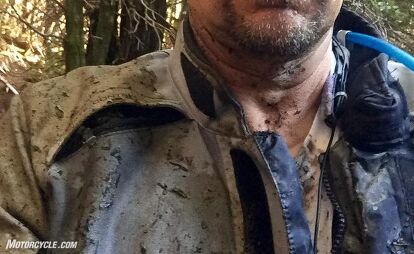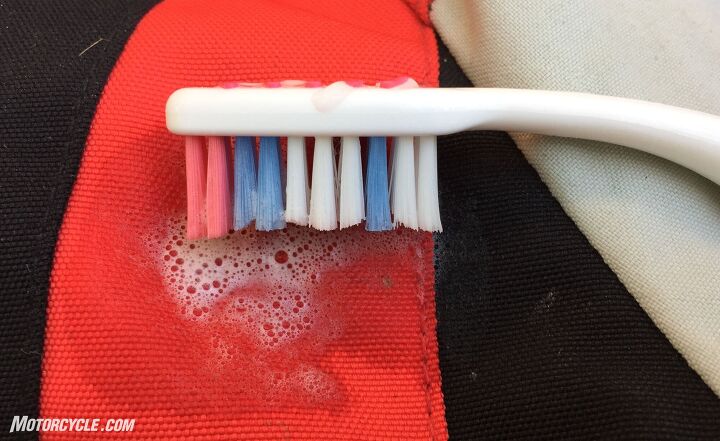How To Clean Textile Motorcycle Gear

Follow these steps from filthy to like-new!
When it comes to textile motorcycle gear, there’s a fine line between looking well-traveled and being just plain dirty. If you don’t notice when you’ve crossed that line, usually a riding buddy or someone close to you will let you know. For example, when I returned from my four-day Gold Wing Tour ride from Austin, TX, my wife wrinkled her nose and said, “That jacket’s filthy…and you kinda stink.” So, instead of ending up in a pile on the floor where I wanted to drop it after my 600-mile day (with a 102° fever), I carried my Spidi suit outside to my garage office and hung it up where it wouldn’t offend her delicate sensibilities. The things we do for love.
MO Tested: Spidi 4Season H2Out Suit Review
Perhaps you’ve got dirty textile riding gear that you want to – or is that need to – clean. The process is actually pretty easy if you keep a couple factors in mind. First, and most importantly, while textile riding gear is tough enough to handle the abrasion of asphalt in a tumble, some of the treatments and/or membranes used in weatherproofing is/are quite delicate. So, you need to take this into consideration. Always consult the care tag in your suit to see what the manufacturer recommends. Typically, the gear will say hand wash only in luke-warm water. (In fact, of all the textile gear currently in my closet, only my trusty 20-year-old Aerostich suit recommends machine washing.) Every textile suit I have ever checked says do not bleach – which also means that you should check the contents of your laundry detergent to make sure it doesn’t contain bleach. Also, never use any form of fabric softener since it could adversely affect your gear’s waterproofing.
Before you wash your gear, you’ll want to perform some spot cleaning on any particularly dirty sections of the garment’s exterior. In fact, you should spot clean your gear whenever you notice any egregious new bug impacts. This will keep the bug guts from working their way into the fibers and possibly becoming a permanent stain.
Wet a section of a clean towel and use it to moisten the offending grime for a moment. Next, try wiping the dirt away with a clean, wet section of the towel. You may have to repeat this step a few times. (Remember, you’re trying to lift away the dirt, not grind it into the fabric.) If this doesn’t work to your satisfaction, you can try a drop of mild laundry detergent (I use Woolite, but you can also buy textile detergent from gear manufacturers) on a soft-bristled toothbrush. (I know people who use a larger sized soft-bristled brush, but I worry that it is too easy to use too much force with a larger brush and possibly damage the garment.) If this is a prewash cleaning, you can leave the detergent on the fabric. If not, use the wet towel to remove the detergent. Again, this may take several applications of the towel.
By hand or machine?
I know, I know, I said you should follow the manufacturer’s recommendations for garment cleaning, but I’m gonna step out on a limb here and say that it’s safe to use a front-loading HE (high efficiency) washing machine that has a hand wash cycle. The problem with machine washing, I have been told, is that the twisting motion of the center agitator in most top-loading washing machines puts too much stress on textile riding gear – particularly their waterproof membranes. After watching the hand wash cycle on my front-loading washer, I can honestly say that it is more gentle on the textiles than I am when performing the chore in a tub or sink.
Regardless of which washing technique you chose, you’ll need to make sure that all of the garment’s armor has been removed. Similarly, go through every pocket and make sure that it is empty before zipping or snapping it closed for the wash. If you don’t, you could be in for a big surprise later.
Textile gear can soak up and hold on to detergent with remarkable tenacity. So, if you machine washed your gear, run it a second time with no soap (and never any fabric softener). With hand washing keep rinsing with fresh water until you can plunge the garment into the water and squeeze it with no soap residue coming to the water’s surface. Some water-resistant gear uses a durable water repellent (DWR) that needs to be recharged after washing. In many cases, using Nikwax Tech Wash in the final hand/machine wash will suffice.
Tumble or hang?
Simply put, do what your gear manufacturer recommends. Some DWRs need to be heated to reactivate, while other waterproofing methods will be damaged by the heat. Do not wring out your garments to make them dry faster because you will risk damaging the waterproof membrane. Hang up your gear and let it drip dry. You’ll want to choose a place that it can drip, too – particularly if you hand-washed it. If you need to speed up the process, you can aim a fan at it for more airflow.
When the gear is dry, some of the finer-threaded fabrics may look wrinkled while heavier ones may not. Some textile gear labels say it is safe to iron them, but I’ve never tried it since I prefer for the fabric to regain its natural patina through riding. However, you should abide by the recommended temperature – again because of the waterproof membranes.
If you follow these steps, you’ll find that your textile gear looks newer and likely performs better over the years you own it.

Like most of the best happenings in his life, Evans stumbled into his motojournalism career. While on his way to a planned life in academia, he applied for a job at a motorcycle magazine, thinking he’d get the opportunity to write some freelance articles. Instead, he was offered a full-time job in which he discovered he could actually get paid to ride other people’s motorcycles – and he’s never looked back. Over the 25 years he’s been in the motorcycle industry, Evans has written two books, 101 Sportbike Performance Projects and How to Modify Your Metric Cruiser, and has ridden just about every production motorcycle manufactured. Evans has a deep love of motorcycles and believes they are a force for good in the world.
More by Evans Brasfield









































Comments
Join the conversation
I just wash with Nikwax Tekwax (I think that's what they call it) and that seems to do the trick, they make an aftermarket waterproofing additive as well. Seems to help on clothes that were marginal to being with.
After years of wear, my jacket had much more ground-in filth than these "before" pictures. I tried many things. I found success with painting on laundry detergent with a basting brush, closing the jacket up in a garbage bag to prevent drying, and LETTING IT SIT for a couple of hours. Time is your ally here. I then laundered it, and got substantially better results than laundering alone.
The water resistance was already gone before this.